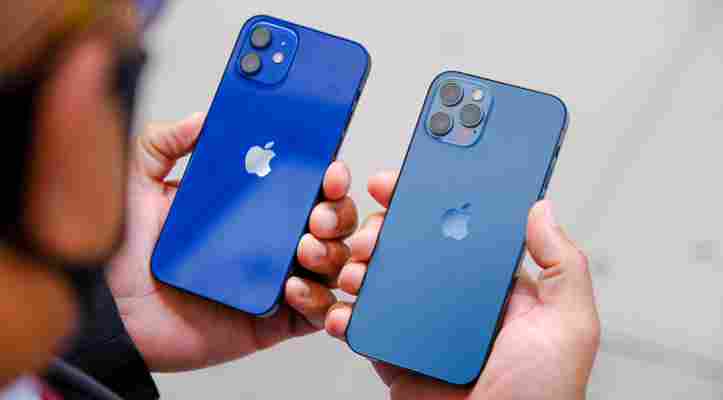Image Credit: Brian Oh/Engadget

Performance and 5G
The iPhone 12 and 12 Pro have yet another thing in common: Apple's new A14 Bionic chipset. The company's new silicon is notable for a few reasons, like the fact that it's the first commercially available 5nm chipset, which gave Apple the transistors needed to design a more powerful CPU and GPU. It also has a vastly improved Neural Engine to speed up apps and features that rely on neural networks for voice recognition, facial detection, and more. Also, it’s just damned fast. As in, it-handled-everything-I-threw-at-it-without-a-fuss fast.
Of course, exactly how fast these phones feel depends on where you’re coming from. If you already have an 11 or an 11 Pro, you’re probably not going to notice a huge difference in day-to-day use. At most, you might notice certain apps opening and loading faster. The boost in performance will feel more palpable if you haven’t upgraded in a long time, particularly if you play a lot of games or edit videos. No matter which of those categories you may fall into, neither the 12 nor the 12 Pro will leave you wanting for power in the slightest. And if you're the type to put faith in benchmarks, the iPhone 12 series stacks up favorably against the competition:
iPhone 12 iPhone 12 Pro iPhone 11 Pro Galaxy Note 20 Ultra Pixel 5 iPad Pro (2020) Geekbench 5 CPU (Single-Core) 1589 1595 1332 955 596 1126 Geekbench 5 CPU (Multi-Core) 4008 4099 3417 3176 1563 4681 Geekbench 5 Compute (Metal and Vulkan) 9460 9392 6348 3506 1020 12088
Long story short, you’ll rarely use all of the A14’s computing power. But since we’re Engadget we tried anyway. To help, I turned to a game called BrightRidge, and I use the word “game” loosely here — it feels like a tech demo more than anything. It’s available for Android and iOS, and there are two things that made it especially useful as a testing tool. First, it has enough tweakable graphics settings to rival a proper PC game. And second, it hasn’t been updated in two years. Since it hasn’t been optimized in any way for Apple’s newest iPhones, performance largely boils down to brute force.
With every conceivable option maxed out, the iPhone 12 and 12 Pro typically ran around 25 frames per second with frequent dips into the teens -- technically playable, but hardly pleasant. Last year’s iPhone 11 Pro was in the same ballpark, typically topping out at around 20. To get a sense of the longer-term performance differences, I also tried the game on an iPhone 8 Plus, which struggled to hit 13 frames per second.
Meanwhile, the iPhone 12 Pro has even more going on. In addition to the A14's high-performance CPU and GPU, it comes with 6GB of RAM, compared to just 4GB in the regular 12. Last year, it was widely reported that Apple uses that extra RAM in its Pro-level phones solely for camera features like Deep Fusion but that’s not true -- this time, anyway. All of the iPhone 12 Pro’s RAM is available to any app that needs it, not just the camera, which means it has a slight edge for multitasking. Honestly, I didn’t notice any major difference in performance between these two phones, so the biggest benefit of having this extra memory is probably that it’ll keep the Pro running smoothly as iOS and apps become more demanding.
And then there's what might be the marquee addition to this year's iPhones: 5G support. 5G networks have really started to come into their own this year, but depending on your carrier and where you live, your experience could be wildly different from mine. That's because there are two main flavors of 5G -- slower but more accessible sub-6 and fast but geographically limited mmWave.
I’ve mostly been testing the iPhone 12 and 12 Pro on Verizon and T-Mobile’s 5G networks, and I really can’t overstate this: Your mileage will vary.
Around here at least, T-Mobile’s has been able to go full “layer cake” with its 5G deployments, and in general, I saw speeds range anywhere from 30 to 100Mbps down — in other words, largely on par with the carrier’s LTE speeds. Occasionally, I’d stumble across spots where speeds surged as high as 200-300Mbps down, but that was fairly rare. Meanwhile, Verizon’s approach has been a little different -- it started by installing high-performance mmWave nodes in a handful of cities, and only just recently lit up its nationwide sub-6 5G network.
Despite that difference in 5G philosophy, regular Verizon 5G is a lot like T-Mobile 5G in that you probably won’t see a dramatic difference in download speeds compared to LTE. Things only get wild when you manage to find a spot with a mmWave node nearby, like Manhattan's Bryant Park, and you see a little UW logo pop up. I hit peaks of 1.4 Gigabits down at Bryant Park: At those speeds, hour-long podcasts downloaded in about a second, and I downloaded 6.5 hours of music at the highest possible quality from Spotify in under a minute.
Chris Velazco/Engadget
Don't expect to see mmWave's impact across the board, though, since apps require fine-tuning to really take advantage of these speeds. Netflix, for instance, can download movies and TV shows at full mmWave speed on Android phones, but the company doesn’t seem to have updated its iOS app yet. And while I'd like to be able to download movies from the iTunes Store over 5G, I can't. Even with a data connection that's about five times faster than my home Wi-Fi, iOS still insists I can't download those big files over the air.
And mmWave has some intrinsic issues, too: just outside Bryant Park, I was downloading hours of music in seconds on Verizon's mmWave network, but you really need to be standing in just the right spots. When I tried mmWave again in a park under the Brooklyn-Queens Expressway, just a single step in the wrong direction meant the difference between 900Mbps and 100.
Of course, it’s still pretty early days for 5G, and you can expect faster, more consistent speeds as carriers continue to flesh out their networks. But at least Apple is now giving you the tools to benefit from those changes as they happen.
Even with the sheer amount of new stuff going on in this year’s iPhones, battery life for the 12 and 12 Pro is on-par with what we got out of last year’s small Pro model. In general, that means you can expect between 11 and 12 hours of consistent use on a single charge, and you may see those batteries lasting well into the following day over quieter weekends. Normally that wouldn’t be too bad for phones of this size, but this is one area where the iPhone 12 is actually a little worse than the 11 — last year’s budget flagship could last for a day and a half with very little fuss. If you want a new iPhone and demand the best possible battery life, you might have to wait for the iPhone 12 Pro Max.
